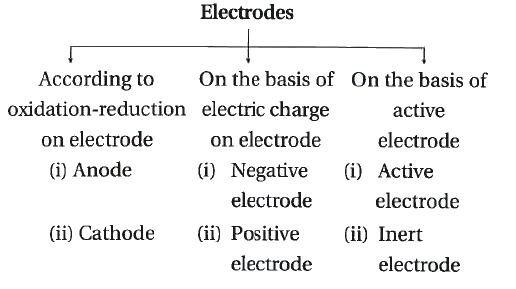Give the type and examples of electrodes.
(a) On the basis of reaction occurs on the surface of electrode: In a galvanic cell, the half-cell in which oxidation takes place is called anode and the other half-cell in which reduction taks place is called cathode.
(b) On the basis of electric charge on electrode: Positive and negative electrode: More number of electrons are present in negative electrode with respect to positive electrode. E.g., in galvanic cell anode is negative and cathode is positive.
(c) Classification based on nature of electrodes:
(i) Active electrode : In cell, electrode which shows either increased or decrease in its weight is called active electrode. if active metal during the reaction get dissolved in the solution, in such cases its weight is reduced. and if during the reaction the ions of solution experience the reduction reaction and get reduced and convert into metal particle which should be deposited on the electrode, in such circumstances the weight of metal increases and they are taking part in the reaction. for e.g., Zn and Cu metals are active electrode in Daniell cell.
Zn→Zn2++2e− (Oxidation) and
Cu2+(aq)+2e−→Cu(S) (Reduction)
Here, weight of Zn decreases and weight of Cu get increases.
(ii) Inert electrode: The electrode in the cell reaction provide only its surface, but do not take part in the reaction, such electrode is termed as inert electrode. E.g., metal line platinum, graphite etc., are used in the half cells having either gas or liquid reactant or product. platinum- H2 gas is the example of inert electrode.

Topper's Solved these Questions
- ELECTROCHEMISTRYBOOK - KUMAR PRAKASHANCHAPTER - ELECTROCHEMISTRYEXERCISE - SECTION-A (Try Yourself)
25 Videos
- ELECTROCHEMISTRYBOOK - KUMAR PRAKASHANCHAPTER - ELECTROCHEMISTRYEXERCISE - SECTION-A (Practice Questions)
3 Videos
- ELECTROCHEMISTRYBOOK - KUMAR PRAKASHANCHAPTER - ELECTROCHEMISTRYEXERCISE - SECTION-E MCQ.s Asked in GUJCET/Board Exam
55 Videos
- CHEMISTRY IN EVERYDAY LIFEBOOK - KUMAR PRAKASHANCHAPTER - CHEMISTRY IN EVERYDAY LIFEEXERCISE - SECTION - E (MCQs ASKED IN GUJCET/BOARD EXAM)
37 Videos
- GENERAL PRINCIPLES AND PROCESSES OF ISOLATION OF ELEMENTSBOOK - KUMAR PRAKASHANCHAPTER - GENERAL PRINCIPLES AND PROCESSES OF ISOLATION OF ELEMENTSEXERCISE - SECTION - E (MCQs ASKED IN GUJET/BOARD EXAMS)
46 Videos
Similar Questions
What are emulsions ? What are their different types ? Give an example of each type ?
View SolutionWhat are emulsions ? What are their different types ? Give one example of each type.
View SolutionWhat are emulsions ? What are their different types ? Give an example of each type ?
View SolutionWhat are emulsions ? What are their different types ? Give example of each type.
View SolutionWhat are emulsions ? What are their different types ? Give example of each type.
View SolutionWhat are emulsions ? What are their different types ? Give an example of each type ?
View SolutionGive one example of each type of dopants.
View SolutionGive an example of anastral type of mitosis.
View SolutionWhat are the three types of salts ? Give one example of each type of salt.
View SolutionGive one example of each the three types of levers.
View Solution
